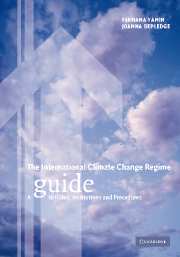Book contents
- Frontmatter
- Contents
- List of figures
- List of tables
- List of boxes
- Foreword by Joke Waller Hunter, Executive Secretary, FCCC
- Preface and acknowledgements
- List of abbreviations
- 1 Introduction
- 2 Overview
- 3 Regime participants
- 4 Objective and principles
- 5 Mitigation commitments
- 6 Flexibility mechanisms
- 7 Research, systematic observation, education, training and public awareness
- 8 Adaptation
- 9 Impacts of response measures
- 10 Finance, technology and capacity-building
- 11 Reporting and review
- 12 Compliance
- 13 Institutions
- 14 The negotiation process
- 15 Scientific and technical input
- 16 Administering the regime
- 17 Linkages
- 18 Evolution of the regime
- 19 Conclusion: taking stock and moving forward
- Appendix I List of Parties, their groups and key statistics
- Appendix II Annex I Party fact sheets: emissions, targets and projections for Annex I Parties and groupings
- Appendix III Table of Articles, issues and COP Decisions
- Bibliography
- Index
14 - The negotiation process
Published online by Cambridge University Press: 16 July 2009
- Frontmatter
- Contents
- List of figures
- List of tables
- List of boxes
- Foreword by Joke Waller Hunter, Executive Secretary, FCCC
- Preface and acknowledgements
- List of abbreviations
- 1 Introduction
- 2 Overview
- 3 Regime participants
- 4 Objective and principles
- 5 Mitigation commitments
- 6 Flexibility mechanisms
- 7 Research, systematic observation, education, training and public awareness
- 8 Adaptation
- 9 Impacts of response measures
- 10 Finance, technology and capacity-building
- 11 Reporting and review
- 12 Compliance
- 13 Institutions
- 14 The negotiation process
- 15 Scientific and technical input
- 16 Administering the regime
- 17 Linkages
- 18 Evolution of the regime
- 19 Conclusion: taking stock and moving forward
- Appendix I List of Parties, their groups and key statistics
- Appendix II Annex I Party fact sheets: emissions, targets and projections for Annex I Parties and groupings
- Appendix III Table of Articles, issues and COP Decisions
- Bibliography
- Index
Summary
Introduction
Parties to the climate change regime are engaged in a continuous round of negotiations, reviewing the implementation of commitments, adjusting existing rules and developing new rules to respond to evolving knowledge and changing circumstances. This negotiation process has become increasingly complex over the past decade, as the number of Parties has risen, the issues on the table have multiplied, and the political profile of climate change has grown. The twice-yearly sessions of the COP/subsidiary bodies, around which the climate change negotiations revolve, are regularly attended by more than 1,000 delegates for subsidiary body sessions, 3–4,000 for COP sessions, and over 5,000 for high profile sessions. These meetings are structured around a crowded agenda, dozens of documents, a plethora of negotiating forums, late nights, and an array of activities on the side by NGOs, IGOs and governments. Moreover, the negotiation process is increasingly spilling out beyond the formal sessions, with a proliferation of workshops and meetings throughout the year.
The formal rules for the conduct of the climate change negotiations are set out in the Convention's Rules of Procedure. A small number of procedural rules are also included in the text of the Convention itself, including rules specifying voting majorities in certain circumstances (e.g. for the adoption of amendments). Further procedural rules have been elaborated through COP decisions, including some applying to the negotiation process in general, and others relating to the specialised bodies.
- Type
- Chapter
- Information
- The International Climate Change RegimeA Guide to Rules, Institutions and Procedures, pp. 431 - 463Publisher: Cambridge University PressPrint publication year: 2004



